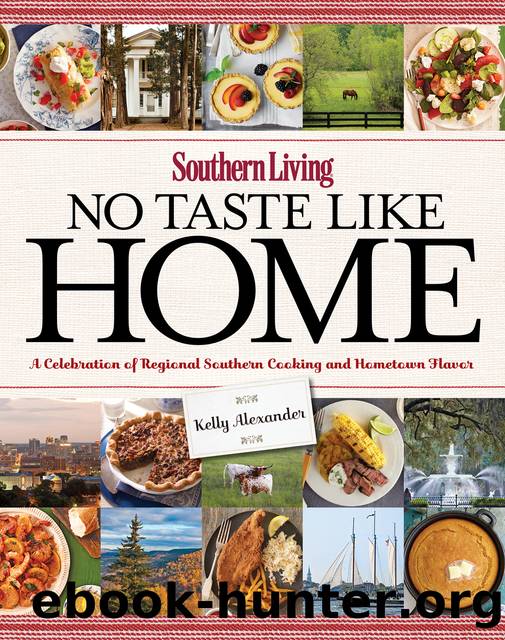Southern Living No Taste Like Home by Kelly Alexander

Author:Kelly Alexander
Language: eng
Format: epub
Tags: CKB000000 CKB030000 CKB002060, Cooking
Publisher: Liberty Street
Published: 2013-09-12T00:00:00+00:00
Raleigh, North Carolina, has an entirely different vibe. Think Atlanta. Think Houston. Think of those fast-growing Southern cities where the pace is hectic and the money is important. Its charms may be mostly unsung, paling in the light of nearby Atlanta and, even closer, the banking center that is Charlotte. But Raleigh is an honest-to-goodness big city—and proud of it.
It bears the name of the 16th-century visionary who helped pave the way for the New World and shares that name with an earlier Raleigh that was lost to history. It’s a fascinating story: After exploring the coast of what would become North Carolina in the 1580s, Sir Walter Raleigh directed colonist John White to establish the “Cittie of Raleigh” on Roanoke Island, about 190 miles east of present-day Raleigh. Virginia Dare, the first child born to English colonists in the New World, was born there in August 1587.
That same year, White took a ship to England for what was to be a quick supply run. But his ship was needed to fend off the Spanish armada. When he finally returned to the newly founded settlement in 1590, it had inexplicably disappeared. It’s now known as the “Lost Colony of Roanoke.” Today’s Raleigh, the capital of North Carolina, was named in honor of the famous explorer in 1792, more than two centuries later.
Raleigh wasn’t a bustling metropolis when it was declared the capital, so taverns, inns, dry goods stores, and other businesses grew up right around the statehouse. And although Raleigh’s citizenry was hit hard by the Civil War—North Carolina lost more men than any other state—the city itself was spared the kind of destruction visited upon so many of its neighbors.
After the war came the railroad, good news for the young city, and a flourishing retail scene followed. Fayetteville Street became the place where folks from all around the state went to see the moving pictures and operas, shop for clothes, and enjoy vaudeville performances. East Hargett Street became a similar kind of Main Street for the area’s African-American community.
A huge housing boom hit the city after World War II, and Raleigh saw the development of the Southeast’s first “shopping center” (don’t call it a strip mall) at Cameron Village in 1949. Shortly thereafter came the two biggest factors in modern Raleigh’s development and workforce: the creation of the Research Triangle and the culmination of the Civil Rights movement when black students took to the streets and staged sit-ins to oppose the Jim Crow laws.
Since the 1970s, the twin forces of suburban sprawl and downtown revitalization have shaped Raleigh, and the transformation is ongoing. Take, for example, the downtown Glenwood South neighborhood, a half-dozen or so blocks northwest of the Capitol. In 2000, it consisted almost entirely of abandoned factories and mills and was deserted after the nine-to-fivers clocked out. Today it’s lined with restaurants and music venues. Aficionados call it GloSo, and The New York Times has accurately described it as “a hive” where hipsters throng.
Download
This site does not store any files on its server. We only index and link to content provided by other sites. Please contact the content providers to delete copyright contents if any and email us, we'll remove relevant links or contents immediately.
Taste by Stanley Tucci(1125)
Cook, Eat, Repeat by Nigella Lawson(1007)
Good Housekeeping Sheet Pan Cooking by Good Housekeeping(970)
A Taste of Venice by Donna Leon(935)
The Ultimate Chinese Recipe Collection: Chinese Cookbook for Delightful Home Cooking by Freeman Sophia(894)
Where Cooking Begins by Carla Lalli Music(866)
Curry by Vivek Singh(856)
Japan Eats! by Betty Reynolds(823)
Homemade Sushi Recipes: Delicious Sushi Rolls to Make at Home: How to Make Sushi at Home by JSUTIN PFEFFERLE(812)
Decolonize Your Diet: Plant-Based Mexican-American Recipes for Health and Healing by Calvo Luz & Rueda Esquibel Catriona(756)
Beginner Spatzle Recipes Cookbook: Delicious & Easy Spatzle Recipes for Beginners to German Cuisine by Stephanie Sharp(750)
Half Baked Harvest Cookbook by Tieghan Gerard(748)
Modern Cajun Cooking by Leigh Ann Chatagnier(737)
The Saffron Tales: Recipes from the Persian Kitchen by Yasmin Khan(716)
The World Sauces Cookbook: 60 Regional Recipes and 30 Perfect Pairings by Mark C. Stevens(703)
101 Chillies to Try Before You Die (101 to Try Before You Die) by David Floyd(700)
Boba by Stacey Kwong(689)
Chinese Takeout Cookbook: Favorite Chinese Takeout Recipes to Make at Home (Takeout Cookbooks Book 1) by Lina Chang(645)
Soups for Every Mood: A Step Closer to Chinese Culture and Delicacies by Hope Ivy(625)
